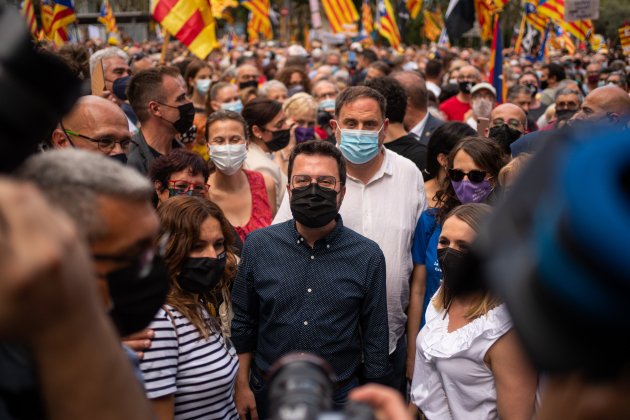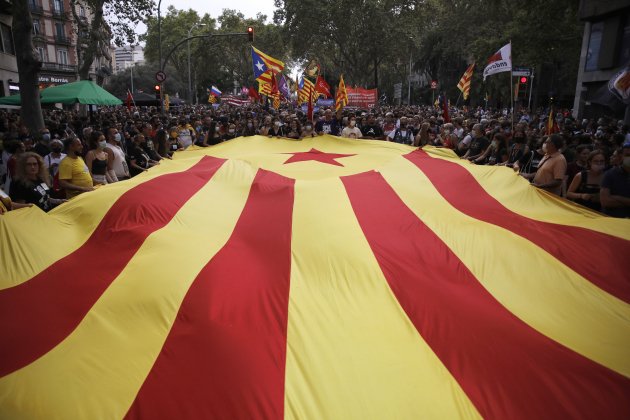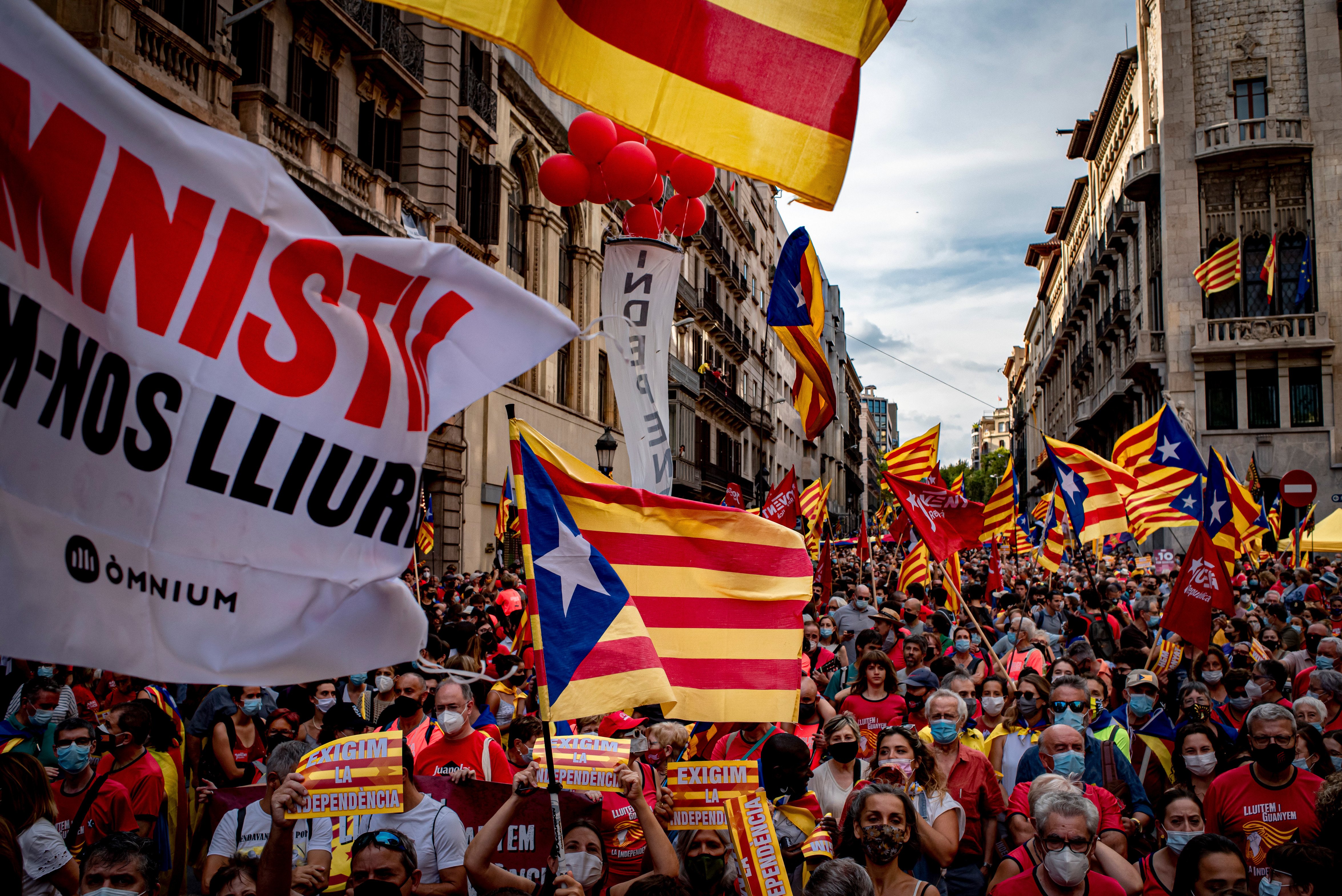On the face of it, it always had to be a day when the independence movement could return to its decade-long tradition of massive marches. After 2020's Catalan National Day, or Diada, ended up being defined by the pandemic, with an austere and deflated September 11th, last year's celebration still retained many anomalous aspects. Despite the fact that the Catalan government had removed the ten-person limit on gathering sizes a few days before the key date, masks still maintained their protagonism in all the institutional events as well as in the unitary independence demonstration, which according to the organizers attracted 400,000 people (a figure that exceeded expectations). The Diada of 2022, no longer with the vestiges and caution dictated by the pandemic, seemed the moment for a return to full normality. And indeed, it will be so in relation to the institutional events and political actions, which will be numerous. But this year's Catalan National Day will also be a day marred not by the pandemic, but by the squabbles within the independence movement groups as a result of president Pere Aragonès' decision not to attend the unitary demonstration. Despite this - maybe even because of it - the opportunity remains for the mobilization to be a moment when the grass roots supporters of the Catalan independence movement enable it to recapture its strength on the street.
As every year, the Diada Nacional begins a day earlier, on September 10th, with a couple of traditional events in the evening. To start, there will be the usual torchlight procession to the Fossar de les Moreres, in El Born, paying tribute to those who fell during the Siege of Barcelona in 1714, with the political presence of several groups, including both the pro-independence governing parties ERC and Junts. There is also the institutional speech by the president of the Generalitat, delivered this year from the Roman Forum in Empúries, in line with Aragonès's wish to "bring the institutions closer" to the whole territory. And early on Sunday morning, already September 11th, there will be the traditional floral offering at the monument to Rafael Casanova, in Barcelona, with the presence of the Catalan president, the two parties that make up the Catalan executive, the PSC and the Comuns, and other Catalan administrations and institutions.
Òmnium does attract the president
It is from 12 noon onwards that the main protest events of the day begin. From 10am, Òmnium Cultural will be operating in its space on Passeig Lluís Companys, under the Arc de Triomf, with a fair of non-profit organizations and later a concert featuring stars of TV3's Eufòria talent show. Before the music, however, the cultural body's central event will take place at noon, the political event under the slogan 'Let's make a free country' which will stand out for its transversality: the speech by the Òmnium president, Xavier Antich, will be delivered in the presence of a full cross-section of the independence movement, without any absences. The institutions, the civil society groups and political parties will all be there, with delegations led by Oriol Junqueras, Marta Vilalta, Carme Forcadell and Raül Romeva on behalf of ERC; Laura Borràs and Jordi Turull for Junts; and the CUP, with the presence of Dolors Sabater and Carles Riera; in addition to the Catalan National Assembly (ANC), with Dolors Feliu. Even the president of the Generalitat, Pere Aragonès, will be there, the figure who has become one of the protagonists of the day, despite trying to avoid it.

The ANC is confident of success, despite the ERC offensive
Indeed, the president himself fueled the controversy after announcing a week ago that he would not participate in the main Diada event, the unitary pro-independence march. A decision that generated tension between the parties, and also with the ANC. The reason he alleges is the message of the mobilization, which accuses the parties of having "got comfortable" and "set to one side" the conflict with the Spanish state, as a result of which the ANC has asserted the need to take over the lead from the parties and "put the heat on the institutions" if necessary. The key leadership of the ERC party will not be there, and its demand to rethink the message has been rejected by the ANC. Yes, Junts will be there, with its full national leadership and its ministers in the Catalan executive, and also present will be the CUP, with Dolors Sabater. Òmnium Cultural and the Association of Municipalities for Independence also support it.
And as well, the hundreds of thousands of people who will accompany them. With the intention of regaining the strength of independence on the street, the single centralized demonstration in Barcelona seeks to surpass last year's figures, despite the threat of demobilization due to the current context. Unlike other years, when there has been a massive, stationary concentration with a festive spirit, this year's edition will be a moving march and as well seeks to strike a more serious note of determined protest - exemplified by the black colour of the ANC's annual t-shirt - in line with the gravity of the moment for the cause. To ensure a high attendance, the ANC has, as usual, organized large fleets of buses to bring independence supporters to Barcelona from all over the territory, and earlier this week there were already more than 150 filled. Other surprise actions have been held too, with a large banner that will be seen along the route of the march and a macro-sized estelada flag filling Plaça Sant Jaume during the week.
The public is invited to gather from half past four in the afternoon along the entire Avinguda Paral·lel. This major Barcelona artery has been divided into ten sections nominally allocated on the basis of marchers' place of residence so that the people will be evenly spread along the route and can easily meet up with others from the same towns or districts. It will be at 5.14pm - the symbolic hour of 17:14 on the 24-hour clock- that the march will begin to move along the Moll de la Fusta and Passeig d'Isabel II to Avinguda Marquès de l'Argentera. The forecast is for the head of the protest to arrive at the Estació de França, where a stage will be set up, at half past six. Then the main political event will begin with speeches by Dolors Feliu, Xavier Antich, and the president of the AMI, Jordi Gaseni. The event will end with a musical performance followed by the singing of the Catalan national anthem, Els Segadors.
Concerts, and the Pro-Independence Left at Urquinaona
Beyond the major unitary demonstration, there will be other events whose timing is more or less coordinated with it. At half past six, Òmnium Cultural begins its 'Festa per la Llibertat' under the Arc de Triomf, which will be a set of concerts by Els Pets, Roba Estesa and Lildami, and which will continue until late. And here, as well, there will be an ERC delegation: with Vergés, Vilalta, Forcadell and Romeva present.
And more too. Also at half past six, the Pro-independentist Left has called its followers to Plaça Urquinaona, a square which has become the nerve centre of the most combative part of the independence movement. This gathering will proceed to Passeig Lluís Companys and passing by the Els Pets concert, it will eventually arrive at Plaça Comercial, in front of the El Born cultural centre, at around 8pm. It will be then when the main forces of the left-wing of the independence movement (the CUP, Arran, Alerta Solidària and the Coordinadora Obrera Sindical) will hold their speeches. Beyond the capital, there will also be mobilizations in Girona, Lleida and Reus.

Institutional event with Aragonès closes the day
Finally, the Catalan national day will be closed by the president of the Generalitat, Pere Aragonès, who will lead an institutional event in Plaça Puig i Cadafalch, that is, in front of the four columns at the base of Montjuïc mountain. This is the same location as last year, which on that occasion commemorated the fiftieth anniversary of Pau Casals' speech to the United Nations General Assembly, followed by a musical show. This year, the common thread will be the key episodes in the history of Catalonia since 1714, in particular highlighting and honouring the work that women have carried out during these three centuries, and remembering that the importance of their roles has often been minimized, and even silenced.

